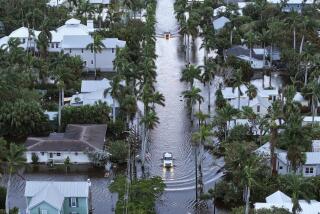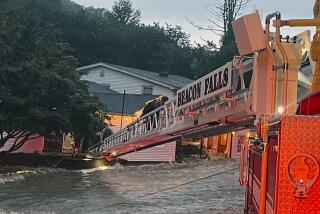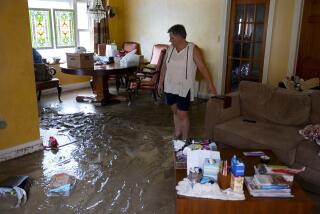Storm’s fury leaves New Yorkers reeling
- Share via
NEW YORK — Fallen trees blocked winding Greenwich Village streets normally jammed with tourists and taxis. Muddy sandbags squished against empty high-rises in the Financial District. The facade of a building had ripped off in Chelsea, leaving apartments bare to camera-toting crowds on the street.
For a change, it wasn’t just out-of-towners wandering slack-jawed at the sights of Manhattan. Facing a massive cleanup from Sandy’s devastation Tuesday, New Yorkers were in a state of disbelief as they realized that America’s largest city, for all its museums and Broadway shows, its noisy subways and neon-lighted squares, was no match for a super storm.
“The weirdest thing is going from being totally plugged in to being totally incommunicado,” said Carlos Cucurella, as he described the second when his world — and that of more than a quarter-million other residents of Lower Manhattan — went dark when the storm suddenly walloped the city about 8:30 p.m. Monday.
Cucurella had been in his West Village apartment watching coverage of the storm on TV while following Facebook and Twitter updates and swapping text messages with friends.
Then a transformer exploded at a midtown Con Edison electrical substation. His six-story building and hundreds of others lost power. In an instant, much of Manhattan’s brilliant skyline became a gloomy shadow against the night sky.
Over the next 30 minutes, as a moon-driven high tide surged in at record levels, and the storm sent the Atlantic Ocean sloshing into New York Harbor, rivers of cold gray water suddenly ran 3 feet deep on some city streets.
That’s when Grace Martinez looked out her third-floor window on the Lower East Side and saw something she’d never seen before: cars floating down Avenue C.
Upstairs, her neighbor, Luzdelia Cruz, got a call from her sister. “There’s a guy going by in a jet ski,” she told Cruz.
Just as quickly, the flood began to recede. By 1 a.m. Tuesday, it was over.
Only it wasn’t. The city used as a location for countless Hollywood disaster movies suddenly looked like the real thing, complete with the soundtrack of wailing sirens.
Officials said it would take at least three or four days to restore power, perhaps much longer. They also could not say when the subways — the arteries and veins that move this city of 8.3 million people — might run again. Even the officials seemed to be stunned by the storm’s fury, and the realization that all their preparations hadn’t been nearly enough.
“Last night was really frightening,” said Gov. Andrew Cuomo. He described watching the Hudson River pour into the vast construction pit at the site of the former World Trade Center towers — and flood the automobile tunnel linking Manhattan and Brooklyn.
The recovery is “going to be a lot worse than we thought,” Cuomo said. “This is a long-term recovery and reconstruction effort.”
At least 18 people died in the city, and there were several near catastrophes. Several hospitals were forced to evacuate patients — including newborns cuddled in the arms of nurses — at the height of the storm when their backup power systems failed or were flooded.
With elevators out at NYU Langone Medical Center, patients were carried on stretchers down long stairwells and loaded into dozens of ambulances that lined up in the dark and the rain.
A construction crane whose boom snapped early in the storm was left dangling more than 75 stories above midtown Manhattan. Buildings nearby were evacuated and streets closed off. Somehow, the broken boom hung to the crane’s cab through the night, despite wind gusts that reached a reported 100 mph. It still hung there Tuesday.
On Breezy Point, a seaside neighborhood in Queens, a blaze roared out of control, leaping from home to home over the flooded streets. By Tuesday morning, 110 homes had been gutted by the fire, leaving charred ruins, sand mixing with ashes as waves crashed onto the beach nearby.
“The winds were just devastating, blowing from one building to the next one,” said New York Mayor Michael R. Bloomberg.
Bloomberg had ordered residents of Breezy Point and about 375,000 people in other low-lying areas to evacuate before the storm. The city set up more than 70 shelters to accommodate those who had nowhere else to go.
Amanda Teitler was among the many city dwellers who did not leave her home.
Living on the seventh floor of an apartment building, Teitler figured she would be fine. She was, but her building’s garage and lobby, on Horatio Street near the banks of the Hudson River, weren’t.
“The river came in 3 feet high,” said Teitler, who was in her apartment when the power went out. She went downstairs to see the Hudson pouring in and rising fast. “It was crazy,” she said.
Her main worry was her mother in the Rockaways, a badly hit beach area. The contents of the family’s basement had washed down the street.
Bloomberg said more than 7,000 trees were reported downed or damaged, and Central Park and all the city’s other parks remained closed because of the danger of falling trees and branches.
On 8th Avenue, crowds stood and gawked at the apartment building that lost its facade during the storm. The structure, squeezed between a giant bank and a 24-hour check-cashing business, looked like a giant dollhouse. The blue walls and dark wood furniture in the four apartments were exposed to the wind and rain, and the eyes of New York.
As the afternoon wore on, the streets began filling with people and cars. Some edged into intersections devoid of working traffic signals, as police tried to keep order. Lines more than 20 feet deep formed at the few delis open and serving hot coffee. Locals who might otherwise be in their offices strolled and chatted, taking pictures of the mess.
Some things inched back to normal. Street sweepers hit the debris-clogged roads, their whirring brushes clearing the way for vehicles to pass. Most bridges connecting the city’s five boroughs reopened. The New York Stock Exchange was expected to reopen Wednesday. So was one airport, John F. Kennedy International. Even trash pickup was supposed to restart.
Perhaps most important for a city that depends on public transportation, buses began running again Tuesday evening, and the rides were free.
Times staff writer Meredith Blake in New York contributed to this report.
More to Read
Sign up for Essential California
The most important California stories and recommendations in your inbox every morning.
You may occasionally receive promotional content from the Los Angeles Times.











